UNIT 3
Ratio Analysis
Ratio analysis techniques
Ratio analysis is used to evaluate relationships among financial statement items. It is used to identify trends over time for one company or to compare two or more companies at one point in time. Financial statement ratio analysis focuses on three key aspects of a business: liquidity, profitability, and solvency.
Ratio analysis is concerned with the calculation of relationship to provide indicators of past performance in terms of critical success factors of a business. This is an accounting ratio. The accounting ratio offer quick ways to evaluate a business's financial condition.
According to Accounting Scholar, ratios are the most frequently used accounting formulas in regard to business analysis. Analyzing your finances with these ratios helps you identify trends and other data that inform important business decisions.
Key takeaways - Ratio analysis compares line-item data from a company's financial statements to reveal insights regarding profitability, liquidity, operational efficiency, and solvency.
Different types of accounting ratio
- Liquidity ratios
These ratios are used to evaluate the company ability in paying its debts, usually by measuring current liabilities and liquid assets. This determines the ability of the company to pay off short-term debts. These are some common liquidity ratios:
- Current Ratio = Current Assets/Current Liabilities:
It is also known as working capital ratio. The purpose of this ratio is to measure the company ability to pay off short-term debts by liquidating the assets. Current assets includes stock, debtors, cash and bank balances, bills receivable, etc. current liabilities includes creditors, bank overdrafts, outstanding expenses, etc. The ideal ratio is considered to be 2:1
- Quick Ratio = Quick Assets/Current Liabilities:
This ratio is similar to the current ratio above, except that to measure "quick" assets, which includes “Cash + Cash Equivalents + Short Term Investments + Accounts Receivables”. The ideal ratio is 1:1.
- Net Working Capital Ratio = (Current Assets - Current Liabilities)/Total Assets:
By calculating the net working capital ratio, the company is calculating the liquidity of the assets. An increasing net working capital ratio indicates that the business is investing more in liquid assets than fixed assets.
- Cash Ratio = Cash/Current Liabilities:
This ratio tells the ability of business in covering its debts using only cash.
- Cash Coverage Ratio = (Earnings Before Interest and Taxes + Depreciation)/Interest:
The cash coverage ratio is similar to the cash ratio, but it calculates the business ability to pay interest on its debts.
- Operating Cash Flow Ratio = Operating Cash Flow /Current Liabilities: This ratio tells you how your current liabilities are covered by cash flow.
2. Profitability ratios
This ratio is used by accountant to measure a business's earnings versus its expenses. Profitability is the ability of a business to earn profit over a period of time. The profitability ratios show the combined effects of liquidity, asset management and debt management on operating results. These are some common profitability ratios:
- Gross profit margin = (Gross Profit/Net Sales)*100
This ratio determines the basic profitability of the firm. The ratio is represented as a percentage of sales. Higher the ratio, the higher is the profit earned on sales
- Operating profit margin = (Operating Profit/Net Sales)*100
This ratio measures the equation between the cost of operating activities and the net sales, or revenue from operations. This ratio expresses the cost of goods sold as a percentage of the net sales. Lower the ratio, lower the expense related to the sales
- Net profit margin = (Net Profit/Net Sales)*100
This ratio measures the ultimate profitability. Higher the ratio, the more profitable are the sales.
- Return on Assets = Net Income/Average Total Assets:
The return on assets ratio indicates how much profit businesses make compared to their assets. Higher the return, the more efficient is the management in utilizing its asset base
- Return on Equity = Net Income/Average Stockholder Equity:
It measures how much the shareholders earned for their investment in the company. Higher percentage indicates better return to investors.
- Return on capital employees = profit before income and tax/capital employees:
This ratio measures the overall efficiency of the utilization of the firm’s funds. It indicates the productivity of capital employed.
- Earnings Per Share = Net Income/Number of Common Shares Outstanding:
The earnings-per-share ratio is similar to the return-on-equity ratio, except that this ratio indicates the company profitability from the outstanding shares at the end of a given period.
3. Leverage ratios
A leverage ratio is a important indicator of financial strength, it sees how much of the company's capital comes from debt and how the company can meet its financial obligations.
- Debt-to-Equity Ratio = Total Debt/Total Equity:
This ratio compares the company’s total debt to its total assets. The higher the debt ratio the more difficult it becomes for the firm to raise debt.
- Equity ratio = (Ordinary Shareholder’s Interest / Total assets)*100:
This ratio measures the strength of the financial structure of the company. A high equity ratio reflects a strong financial structure of the company.
- Capitalization ratio = Long-Term Debt/(Long-Term Debt + Total Equity):
This ratio measures the debt component of a company’s capital structure. A low level of debt and a healthy proportion of equity in a company’s capital structure is an indication of financial strength.
4. Turnover ratios
Turnover ratios are used to measure the company's income against its assets. There are many different types of turnover ratios. Here are some common turnover ratios:
- Inventory Turnover Ratio = Costs of Goods Sold/Average Inventories: The inventory turnover rate indicates how much inventory sold in a year or other specified period.
- Assets Turnover Ratio = Sales/Average Total Assets: This ratio is a good indicator of how good the company uses its assets to produce revenue.
- Accounts Receivable Turnover Ratio = Sales/Average Accounts Receivable: this ratio evaluates how quickly the company is able to collect funds from its customers.
- Accounts Payable Turnover Ratio = Total Supplier Purchases/(Beginning Accounts Payable + Ending Accounts Payable)/2): This ratio measures the speed at which a company pays its suppliers.
5. Market value ratios
Market value ratios deal entirely with stocks and shares. Many investors use these ratios to determine if your stocks are overpriced or underpriced. These are a couple of common market value ratios:
- Price-to-Earnings Ratio = Price Per Share/Earnings Per Share. Investors use the price-to-earnings ratio to see how many times a stock is trading (its price) per each rupee of EPS
- Market-to-Book Ratio = Market Value Per Share/Book Value Per Share. This ratio compares your company's historic accounting value to the value set by the stock market.
Key takeaways - Ratio analysis compares line-item data from a company's financial statements to reveal insights regarding profitability, liquidity, operational efficiency, and solvency.
Significance of ratio analysis
Ratios are very useful tools to analyze the financial performance of the enterprise over a period of time. Against the industry average the efficiency of the enterprise can also be judged. The vertical ratio analysis helps the analyst to determine whether performance of the firm at a point of time is good, questionable or poor.
Likewise, use of ratios in horizontal analysis indicates whether the financial condition of the firm is improving or deteriorating and whether the cost, profitability or efficiency is showing an upward or downward trend.
In the task of planning and forecasting, a study of the trend of strategic ratios will help the management. The investment decisions at times are based on the condition revealed by certain ratios. In this way it serves as handmaid to the management.
- To give meaning to absolute figure: most numbers in the financial statements of companies are found to be vague and meaningless if a scientific method of ratio analysis is not performed on the figures. For example, EPS of 3.3 will not make much if there is no information on what EPS was for last year.
2. For planning and forecasting: ratio analysis helps the manager to find a trend and based on that trend, project into foreseeable future what an item of financial statement would most likely be.
3. As a basis of decision making: ratio analysis output can be used as a basis for making investment decision. After calculating some investment ratios an investor would be better equipped to make decision of whether to invest in a project or not to invest.
4. To compare results and performance: an insight of how management are doing can be obtained by calculating ratios.
5. For analysis of strengths and weakness: ratio analysis helps the management to find out department or division that is not relatively doing well and then take some corrective actions to improve the performance.
6. For analyzing change in the form of trend: Investors are more interested in analyzing the trend of the company. This trend is found using ratios and ratio analysis.
Key takeaways - Ratios are very useful tools to analyze the financial performance of the enterprise over a period of time.
Limitation of ratio analysis
- Historical Information: Information used in the analysis is based on real past results that are released by the company. Therefore, ratio analysis metrics do not necessarily represent future company performance.
2. Inflationary effects: The Company releases their financial statements periodically and, therefore, there are time differences between each release. Real prices are not reflected in the financial statements, if inflation has occurred in between periods. Until the numbers are adjusted for inflation, they are not comparable across different periods
3. Changes in accounting policies: financial reporting is affected. If the company has changed its accounting policies and procedures. In this case, the key financial metrics utilized in ratio analysis are altered and the financial results recorded after the change are not comparable to the results recorded prior to the change. The notes are given in the financial statements section to inform the changes made.
4. Operational changes: A company may change its operational structure, from their supply chain strategy to the product that they are selling. The comparison of financial metrics may be misleading before and after the operational change occur about the company’s performance and future prospects.
5. Seasonal effects: An analyst should be aware of seasonal factors that could potentially result in limitations of ratio analysis. If the ratio analysis are not adjusted to the seasonality effects may lead to false interpretations of the results from the analysis.
6. Manipulation of financial statements: Based on information reported by the company in its financial statements the ratio analysis is done. The company’s management may manipulate the information to report a better result than its actual performance. Hence, ratio analysis may not accurately reflect the true nature of the business.
Key takeaways – limitation of ratio analysis are historical information, changes in accounting policies, manipulation of financial statements.
Funds flow statement
A fund flow statement is a statement in summary form that indicates changes in terms of financial position between two different balance sheet dates showing clearly the different sources from which funds are obtained and uses to which funds are put.
Definition
Roy A. Fouke defines fund flow statement as “a statement of sources and application of funds is a technical device designed to analyse the changes in the financial condition of a business enterprise between two dates.”
Steps for preparing funds flow statement
- Determine the change (increase or decrease) in working capital.
- Determine the adjustments account to be made to net income.
- For each non-current account on the balance sheet, establish the increase or decrease in that account. Analyze the change to decide whether it is a source (increase) or use (decrease) of working capital.
- Be sure the total of all sources including those from operations minus the total of all uses equals the change found in working capital in Step 1.
General rules for preparing funds flow statement
- Increase in a current asset means increase (plus) in working capital.
- Decrease in a current asset means decrease (minus) in working capital.
- Increase in a current liability means decrease (minus) in working capital.
- Decrease in a current liability means increase (plus) in working capital.
- Increase in current asset and increase in current liability does not affect working capital.
- Decrease in current asset and decrease in current liability does not affect working capital.
- Changes in fixed (non-current) assets and fixed (non-current) liabilities affect working capital.
Format of funds flow statement
The fund flow analysis involves the preparation of two statements
- Statement or Schedule of Changes in Working Capital: The main purpose of a fund flow statement is to explain the net change in working capital.
The Schedule or Statement of changes in working capital is a statement that compares the change in the amount of current assets and current liabilities on two balance sheet dates and highlights its impact on working capital.
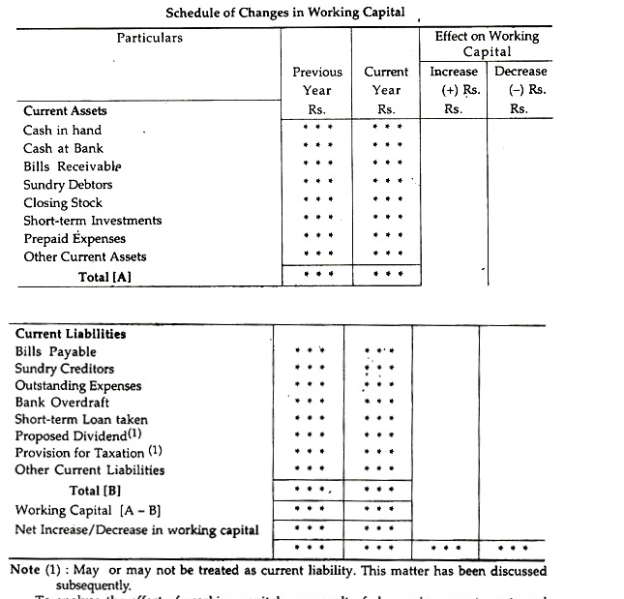
2. Funds flow statement: After preparing the schedule of changes in working capital, the next step is to find out the different sources and applications of funds through preparation of funds flow statement. This statement GIVES emphasis on the changes in the fixed assets and fixed liabilities. The statement may be prepared either in ‘T form’ or in ‘Vertical form’.
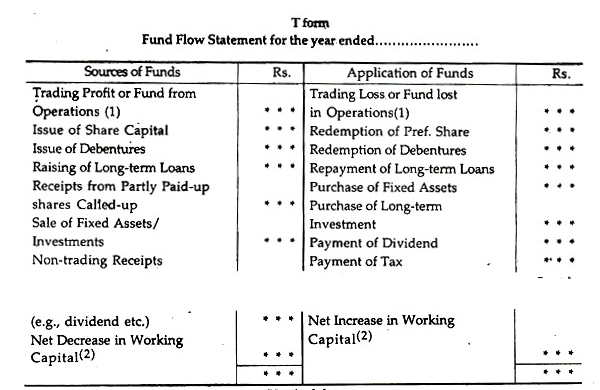
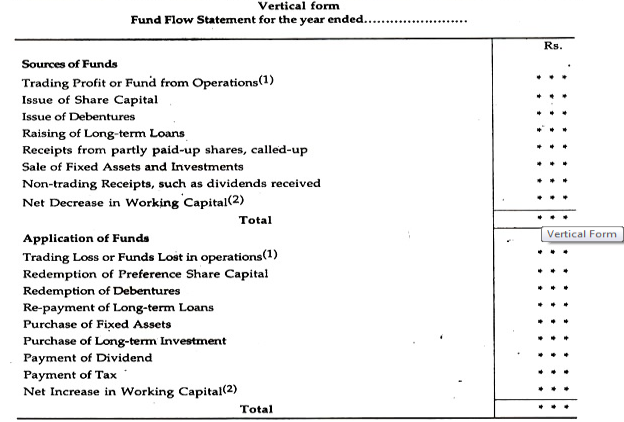
Key takeaways - A fund flow statement is a statement in summary form that indicates changes in terms of financial position between two different balance sheet dates
Cash flow statements
Definition
A cash flow statement is a financial statement showing the movements of cash and cash equivalents during the period. This financial statement demonstrates the effects of changes in the accounts of balance sheet on cash and cash equivalents.
Cash flow statement is an important part of financial statement. Cash flow statement provides useful information to the investors and creditors. The investors want to know the financial stability and soundness of the business.
Cash includes cash on hand and demand deposits. Cash equivalents means short term highly liquid investments that are readily convertible into cash for meeting short term cash commitments. These cash are not used for investments and other purposes.
Objectives of cash flow statement
- Useful in short-term financial planning.
- Useful inefficient cash management.
- Helpful in formulation of business policies.
- Assists in preparation of cash budget.
- Used for assessment of cash flow from various activities, viz operating, investing and financing activities.
Format

Cash flow from operating activities – the operating activities includes the primary or main activities of an enterprise. Cash flows from operating activities are primarily derived from the main activities of the enterprise. They generally result from the transactions and other events that enter into the determination of net profit or loss.
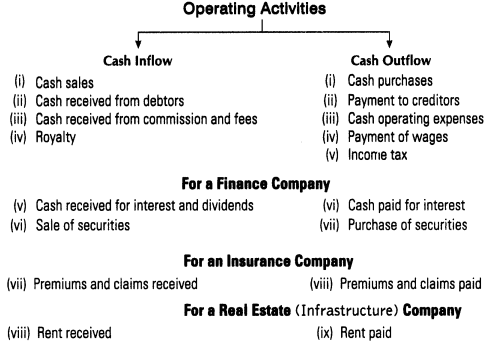
Cash flow from investing activities - Investing activities consist of the acquisition and disposal of long-term assets and other investments which are not included in cash equivalents. The purchase and sale of long-term assets or fixed assets such as machinery, furniture, land and building, etc. are included in investing activities.
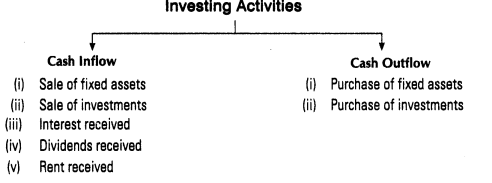
Cash flow from financing activities - Financing activities comprises of owners capital and borrowings or long-term funds or capital of an enterprise, e.g., cash proceeds from issue of equity shares, debentures, raising long-term bank loans, repayment of bank loan, etc.


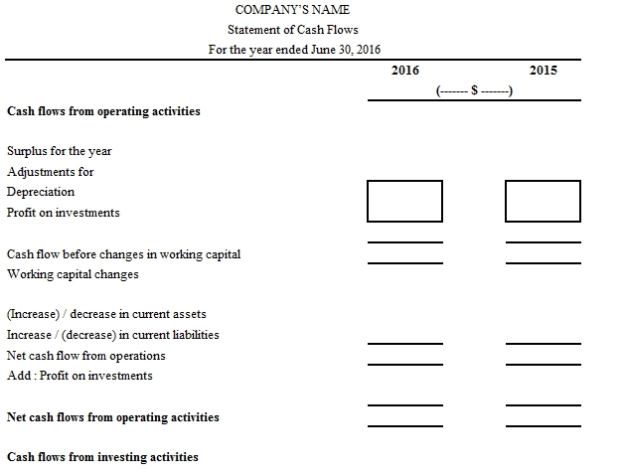

Key takeaways -A cash flow statement is a financial statement showing the movements of cash and cash equivalents during the period.
Sources
- S. P. Gupta : Management Accounting
- B. K. Mehta & K. L. Gupta : Management Accounting
- Manmohan and Goyal : Management Accounting
- Hingorani and Others : Management Accounting
- R. N. Anthony : Management Accounting
- Agarwal and Mehta : Management Accounting